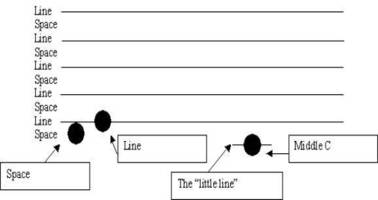Stickers for Reading Music
I devised stickers for reading music because I was tired of kids guessing where the notes were. I wanted a system based on exactly what they could see, not a group of unseen and unstated rules.

The old method involves two bits of memorization: One, the child memorizes the names of the notes as they appear on the page. Two, the child then memorizes the name of each key on the piano, and correlates the two, the name of the note, and the name of the key.
I Can Read Music e Book Download
This is all well and good, but kids are not always good at memorization. And if they can't remember the names of the notes, they have great difficulty remembering the names of the keys. Thus what is needed is a system based solely on what the child can see on the page and on the keys.
The Stickers Denote The Five Lines Of The Staff Plus Middle C
On the keys, we place six stickers, five blue and one red:

The five blue stickers are the five lines of the musical staff. The five blue stickers denote the location of the five lines of the staff (see below.) The red sticker shows the location of Middle C.
By giving kids a reference point (the stickers) we allow them to develop visual habits and associations more quickly. The first habit to instill is the ability to find Middle C. It is the center of the reading music universe.

This is Middle C (denoted by the RED sticker) and is the first note that kids learn at the piano.
Middle C Finding Game
Look through some pages of music in, for example, a book such as I CAN READ MUSIC, and help the child identify the graphic symbol for the note Middle C (the symbol directly above this, the circle with the little line through it.)
Look below for a page with lots of Middle C’s to find:

Make a contest of it, saying “Who can point to Middle C on the page first?” Then let them win every time after a few tries. Go through page after page, making a game of finding Middle C on the page. Every piano method is the same: they concentrate on the first five notes above Middle C. This requires a little exploration by kids.
Questions About Lines And Spaces
Quiz them about the staff (the five lines and the spaces between) constantly:

Ask them how many spaces are there? How many lines are there? Point to a space. Ask them to point to a line. Point to a note. Is it on a line or a space? Point to another note. Line or space?
They haven't even tried yet to learn the names of the notes. Kids are occupied enough with the task of building visual habits, of really looking at the page.
REFERENCES
Reading Music
Why Delay Reading Music
What Comes After Numbers In Kid’s Piano
You Say Read, I Say Play
Reading Music for Kids Step By Step
The Basic Piano Curriculum for Kids
The Transition From Numbers To Notes
Preventing Kid’s Struggle To Read Music
Resistance To Reading Music Is Age Based
Stay Sane Teaching Kids To Read Music
Helping Children Read Music
Helping Your Child Find Middle C
What Kids Understand About Sheet Music
An Effective Strategy for Kids Reading Music
How To Help Kids Read Music
The Battle To Read Music
Why Is Middle C So Important?
What Comes After Numbers?
Start With Numbers, Then Read Music
Start Kids With Numbers, Then Read Music
Helping Children Read Music
From Numbers To Notes
Why Kids Resist Reading Music
How To Help Your Kids Read Music
Start With Numbers, Then Read Music
Beginner Piano Sheet Music for Kids
Don’t Start With Reading Music
Easy Piano Songs Sheet Music
Piano Letters




